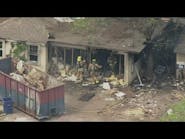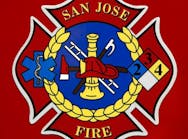For an intelligent man, Robert Braden made a pretty dumb decision on Feb. 8, 1981.
The then-Ketterlinus Junior High School principal ran into the burning school building on Orange Street because he thought he might be able to retrieve some records before the fire spread.
“I was crazy myself going back into the building with it burning like that,” Braden said last week.
Braden turned out to be crazy, lucky and heroic that afternoon. He wasn’t alone, either.
A school Braden and many others loved was destroyed before their eyes 31 years ago due to an act of arson.
The two-story Spanish-style stucco building was a landmark in the community. At one point it was the city’s high school. By the time of the fire, only eighth and ninth grade classes were held at the school.
Just as the campus of the historic school was permanently altered — the fire-ravaged building was never rebuilt — a lot of lives were drastically changed. A few were nearly extinguished before the fire was.
Fire call
Braden arrived at Ketterlinus shortly after 4 p.m., right on the heels of the first firefighters.
“I sure was (heartbroken),” Braden said. “I knew I had to get my thoughts together.”
Instead of just watching Braden thought he’d go into part of the building that wasn’t yet fully engulfed in flames and see what he could salvage from the assistant principal’s office.
At the same time, several firefighters were entering a situation that was even more dangerous than they thought.
All have a slightly different recollection of what transpired inside Ketterlinus, but they know they were fortunate to live to tell their sides of the story.
Escape
While Braden was in the office, firefighters Kenny Skinner, Bubba Stratton and Jerry Blount were trying to find the source of the fire.
After checking the first and second floors, they eventually went into the auditorium, which was near the office Braden was in.
Blount said he remembers pulling a 21/2-inch hose into the auditorium because he’d found flames there. He can’t recall Stratton being there at the moment, but he said Skinner was helping him with the hose.
As he tried to get the hose deeper into the auditorium and closer to the flames, Blount remembers Skinner telling him not to go any farther past the mezzanine (or balcony) because it didn’t seem safe.
Whether it was a matter of seconds or minutes later that their worlds changed, the retired firefighters aren’t sure.
What they do know is that the ceiling came crashing down. Being under the balcony saved the firefighters from getting crushed to death, but the collapse nearly killed them anyway.
“When the roof fell in, it blew us right back into hall,” Skinner said.
Skinner was wearing an oxygen mask, but he couldn’t breathe after the impact because the mask was knocked off his face.
At some point, Skinner said he figured out what the problem was but struggled to clear the mask and lost Blount. He couldn’t have seen the other firefighter who was a foot away at that point.
“You can’t imagine how black that smoke was,” Blount said.
Skinner managed to make his way toward the door, and he’s not sure he would have made it out if not for the assistance of police officer Eddie Lightsey Jr.
While Skinner struggled to freedom, Blount, who didn’t have an oxygen mask, was convinced Ketterlinus was going to be his last fire.
“I knew I wasn’t going to make it out, so I followed the line,” he said.
It led him to the assistant principal’s room.
Route to the light
Braden’s “crazy” decision to run into a smoking Ketterlinus turned out to be a fortuitous one for Blount.
The same can be said of former St. Augustine Record reporter/photographer Jim Sutton’s rash act of running inside.
The racing fire trucks had caught his attention, and Sutton quickly followed the engines and then the smoke to the fire scene. With a camera in his hands, Sutton was inside surveying the situation near Braden when the lights went out.
“The bottom floor was clear, and then it was like somebody flipped the switch,” Sutton said of when the ceiling came down.
“In 5 seconds, it went from being able to see things to just pitch black.”
Added Braden: “All you had was a pillar of smoke. I couldn’t see my hand in front of me. It never dawned on me that the whole ceiling would collapse.”
Enveloped in smoke, Sutton threw a file cabinet through window so he could breathe and see a little bit.
It became a beacon for Blount.
“What saved my life was when they opened the door, and I could see the light,” he said. “I was going to whatever that light was.”
While Blount has always thought he went out through the window, Braden and Sutton remember dragging him out.
Either way, there is no doubt their actions allowed Blount to finish a 30-year career as a firefighter.
“I guess it was just luck I went into the building,” Braden said. “I knew the school, so I could feel my way out. I knew where that front door was.”
Blount was hospitalized for a day because of smoke inhalation, but it wasn’t enough of a scare to lead him to a new career.
“(Firefighting) is either in you or it’s not,” he said.
Rebuilding, recovering
Without taking much time to consider his act of heroism, Braden went back to worrying about getting the school ready to go again.
His actions weren’t even reported to The Record in its coverage of the fire, and Braden said until now he never knew the name of the man he saved.
Although clearly thrilled, pleased he was able to help save another man’s life, Braden also is proud of the way he helped get the school running again.
The entire eighth grade portion of the school was destroyed, leaving just the ninth grade half to use for the rest of the school year.
Less than a week after the fire, classes resumed.
Things were far from normal, of course.
“The fire really took its toll on all of us,” said former Ketterlinus teacher David Bartlam. “We were just heartbroken when it happened.”
The feelings of loss were compounded by the sight and smell of the burned structure. Then, there were the logistical considerations.
With room for only half the students, officials split the school day with ninth graders going in the morning and eighth graders in the afternoon. School didn’t get out until 5:30 p.m.
Bartlam said he taught in the afternoon, which was a struggle. But it was something that brought the teachers and students closer.
“They came up with a good plan and it worked,” Bartlam said. “It was quite an ordeal. Teachers probably became better friends. We had to team up and really make it work.
“The kids were very cooperative. They really pitched in and were great.”
Return to the scene
While some of the people who fought the Ketterlinus fire (there were many more besides Stratton, Skinner and Blount) only visit the school now in their memories, some still have an intimate relationship with it.
Braden currently works for Flagler College as director of field placements in education. He frequently visits practicum students at Ketterlinus, which is now an elementary school.
“It brings back memories when you walk through there,” he said.
Ketterlinus might have even more meaning to Skinner. Not only did he attend school there, he has a daughter who is a student there now.
Skinner’s wife recently showed the fourth grader some of the old photographs of the fire from The Record’s website. Bryn was so excited to see her father in some of the photos that she gave her class a presentation on the fire of 1981.
It could have been the last fire her father ever fought — for a couple of reasons.
“It almost made me give up firefighting,” Skinner said. “That was the first one I went to and thought, ‘Do I really want to do this?’”
But Skinner wound up with a 33-year career, even making captain.
“Being a firefighter was a rewarding career,” he said.
Blount, who came closest to losing his life in the 1981 fire, said he never wavered in his commitment to firefighting. But that doesn’t mean his experience 31 years ago didn’t change him.
“When you come that close to dying, you realize you’re lucky to be here every day,” he said.
Copyright 2012 The St. Augustine RecordDistributed by Newsbank, Inc. All Rights Reserved






